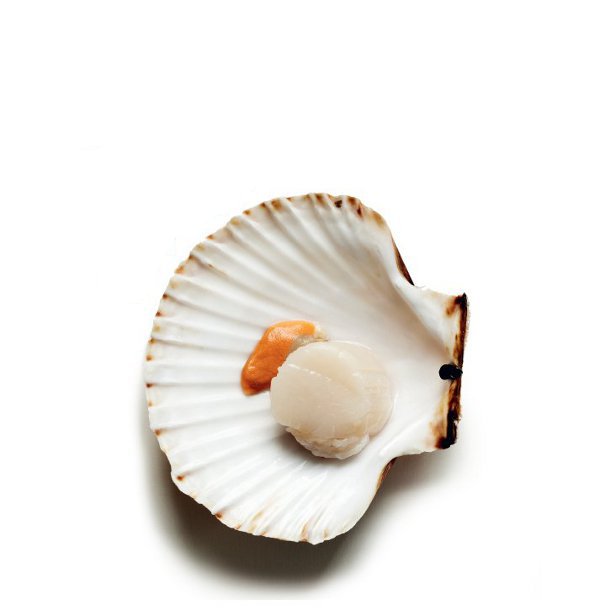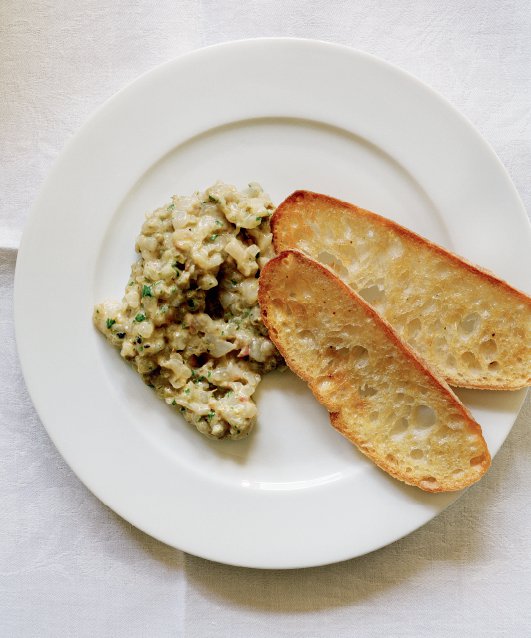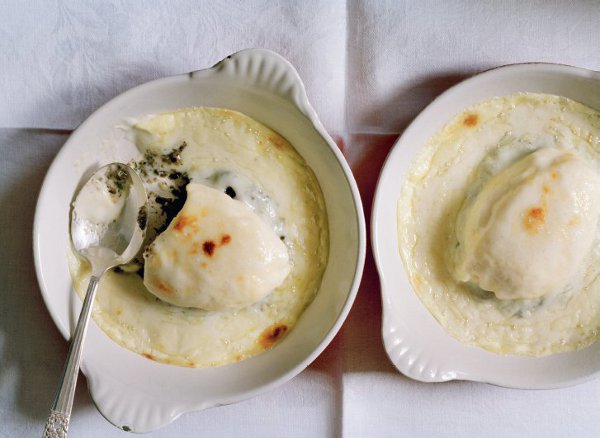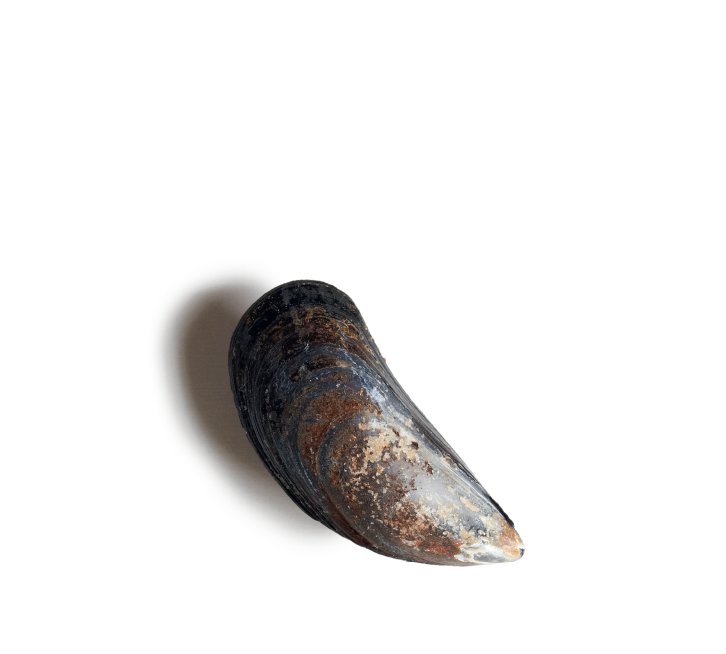Good Cook (21 page)
Authors: Simon Hopkinson

serves 2
2 red onions, very thinly sliced
2 tbsp olive oil
2 tbsp butter
salt and freshly ground black pepper
4 thin slices of calf’s liver, cut into thin strips
1 tbsp sherry vinegar, or excellent quality red wine vinegar
1 tbsp crème de cassis (a mildly alcoholic blackcurrant cordial)
1 tbsp chopped parsley
In its finishing moments, this is a quick dish. Just make sure that you take time to cook the slow beginning: the onions. Most important, this bit, for you need them to be very, very soft and sweet before you add the flash-in-the-pan liver, so keeping it nice and pink within. If you like, and when in the mood, you may cook the onions way in advance, just warming them through before you assemble the final fry-up.
In a heavy-based, preferably non-stick frying pan, cook the onions in 1 tablespoon of the olive oil and all the butter until completely cooked through and soft. They may take on a little color during this time but no matter; the most important thing is that they cook slowly—up to 30 minutes, if necessary. Season lightly with salt and pepper, then tip out into a bowl and put to one side. Wash and dry the frying pan.
Heat the remaining olive oil in the frying pan until hot. Season the calf’s liver with salt and pepper and briefly fry for 20 seconds, while also briskly tossing the liver around until just stiffened. Add to the onions in the bowl, thoroughly mix them together and return to the pan. Quickly heat through and add the vinegar, crème de cassis and parsley. Spoon on to hot plates and serve at once. Very good with softly creamed potatoes, or some equally soft and buttery polenta.

scallops
serves 4, as a first course
7 oz super-fresh sea bass fillet, skinned and any small bones removed
4 oz super-fresh trimmed scallops
lemons and parsley, to serve
for the tartare dressing
3–4 large anchovies, chopped
1 egg yolk
2–3 tbsp extra virgin olive oil
1 tsp Dijon mustard
½ tbsp green peppercorns
a few shakes of Worcestershire sauce
4–5 drops of Tabasco sauce
2 tsp Cognac
1 tbsp chopped parsley
3–4 small gherkins (cornichons), chopped
1 tsp capers
I was first introduced to this astonishingly good raw fish dish by my friend Pierre Martin, owner of Le Suquet restaurant in Chelsea, London. He is an ebullient, opinionated Frenchman and a legendary restaurateur, having introduced the capital’s gourmets to fabulously fresh fish, simply cooked, in the late 1970s when he opened his first place, La Croisette, in Fulham (borders of Chelsea).
However, though originally hailing from Cannes (hence the linked names of his restaurants; another was called Le Quai St Pierre), he cut his teeth at the bar of Le Fouquet’s, Paris, and became its legendary head bartender before moving to London. During this time he befriended one Paul Minchelli, who was chef-proprietor of a chic fish restaurant called Le Duc in the boulevard Raspail.
However, it was while on a trip to Switzerland in the mid 1980s, when he and some mutual friends were to eat at the great Girardet, near Lausanne, that Pierre decided, the following day, we should eat at his friend Minchelli’s Geneva outpost of the Paris Le Duc. This tartare was the first course at lunch—and one, as it transpired, of many to follow … Happy memories.
Cut the sea bass and scallops into small pieces, then mix together. Place on a chopping board and, using a large, heavy sharp knife, chop to a coarse mix; you could do this in a food processor, but the final texture would not be as enjoyable as that manually worked.

However, the tartare dressing is ideal done electrically. Simply put all the ingredients in the processor and work to a coarse purée, but not too smooth; one needs to see some texture. Mix this with the fish and put into a bowl (the texture should be similar, naturally, to steak tartare, so don’t add quite all the dressing if it starts to look sloppy). Cool in the fridge for at least 30 minutes.
Serve in a shallow dish, maybe sprinkled with some extra olive oil and chopped parsley. Cut some lemons and arrange around the tartare with thin, crisp toasts.
serves 4, as a dainty first course
for the mousse
5 oz scallops, trimmed, and any roes removed
1 egg
7 oz very cold double or heavy cream
1 level tsp table salt
pinch of cayenne pepper
for the mushroom duxelles
3 oz shallots, chopped
1 tbsp butter
5 oz button mushrooms, quartered
salt and freshly ground white pepper
3 tbsp dry vermouth
a small squeeze of lemon juice
leaves from 3 or 4 sprigs of parsley
for the mornay sauce
2 tbsp butter
2 tbsp plain flour
9 oz cold milk
3 oz grated Gruyère
1–2 tbsp double or heavy cream (optional)
salt and freshly ground white pepper
a scraping of nutmeg
to finish
a little softened butter
a little grated Parmesan
This delicate little dish—really quite haute cuisine, in fact—is based upon the classic French “quenelle de brochet” served at La Tour d’Argent in Paris. Brochet, the pike, is a dastardly bony fish, with that structure within the flesh defying belief in complexity and stubbornness, almost resisting any removal by the most fastidious and determined of cooks (only the shad, or French “alose,” is an even more cussed critter when it comes to them bones).
Nevertheless, the flesh of the pike is a marvel, having both exceptionally delicate flavor as well as a nicely gelatinous texture once cooked. Both of these qualities are ideal for the making of a fish mousse—or mousseline, to be precise. Or quenelles. Anyway, I am not about to put you—or anyone, including me—through the misery of pike-boning. So, enter the easy, bone-free scallop,
which whizzes itself into the utmost smoothity before you can say Magimix. Because I have been cooking for some time now, I don’t find it any trouble forming the traditional “quenelle” shape, fashioned by molding it between two spoons until egg-shaped. And, if you look closely, you will see that this is how they are presented in the related photograph illustrating the dish. However—and without being in the least patronizing—I have instructed that you should use small molds or ramekins, lightly buttered and cooked quietly in a bain-marie (or steamed, if you wish), at a low oven temperature until just set. If you wish, you might enjoy doing the quenelle thing, which involves the aforementioned spooning process, then dropping them into just simmering (shuddering is a better description), salted water until set. Have a go. You know you want to.

Note: if the scallops come with roes you could fry these in a little butter and garnish the mousses with them. I have also asked for the cream to be weighed as, if you have one of those scales that reverts to zero at the touch of a button, it is so simple to place the bowl of the processor directly on the scales when you first weigh the scallops, then again when you introduce the cream to them, once puréed. Finally, please place the components (but not the motor, obviously) of a food processor in the freezer for 20 minutes before using, as this keeps everything nice and cool while processing; delicate fish can easily begin to “cook” when overworked, and cream is liable to curdle for the same reasons.
Place the scallops and egg in the chilled food processor and briefly work until very smooth. Place in the fridge (not freezer), still in the processor bowl, for 10 minutes. Return to the machine, begin to break down the scallop purée, and then add the cream. Process once more, until thoroughly blended with no streaks of scallop visible. Only now add the salt and cayenne, briefly mixing them in. You will see that the mixture begins to noticeably thicken, due to the salt; don’t ask me why, it just does. Decant the mousse into a bowl, cover with plastic wrap and refrigerate.
To make the duxelles, fry the shallots in the butter until pale golden, then add the mushrooms. Season and stew together until fairly dry and any juices from the mushrooms have been driven off. Add the vermouth and simmer until reduced to almost nothing. Squeeze in the lemon juice, add the parsley and then briefly work in a small food processor, using the pulse button, until the mixture becomes an
even purée—but it should not be over-smooth. Tip into a bowl, cover with a plate and keep warm over a pan of simmering water.
Preheat the oven to 325°F.
For the mornay sauce, take a small saucepan and in it melt the butter. Tip in the flour, stir it around and cook quietly for a few minutes without coloring the mixture (roux). Pour in the milk all in one go and whisk together vigorously until smooth. Cook over a very low heat, stirring now with a wooden spoon, for about 7 minutes, until the sauce has thickened. Now add the Gruyère and stir in until melted, together with the cream if you wish for a slightly richer sauce, and cook for a further 5 minutes or so. Season lightly with salt, pepper and nutmeg, then put on a lid and also keep warm.
Lightly butter 4 small molds or ramekins. Fill with the scallop mousse and smooth the surface. Cover each with a small square of buttered kitchen foil and place in a deep roasting pan. Pour tap-hot water around the molds/ramekins and slide the tin into the oven. Bake for 20 minutes, or until the mousses feel set—only just bouncy—when tentatively pressed with a finger. Heat a broiler to medium-hot.
To assemble and finish the dish, take 4 shallow, ovenproof dishes and lightly butter. Take about a tablespoon or so of the mushroom duxelles and spread into the dish, forming a small, flat circle, roughly the diameter of the top of the mousses. Invert a mousse on to the duxelles and spoon enough mornay sauce over each one so that it is completely covered and with a little sauce running around them in the base of the dishes. Sprinkle each one with a light dusting of Parmesan, then put under the broiler until lightly glazed and pale golden. Serve forthwith. Just delicious.
serves 4, delicately
4 tbsp butter
2 leeks, white parts only, sliced and rinsed 2 bunches of parsley (large, supermarket size, either flat or curly varieties), stalks and leaves separated, stalks roughly chopped
1 large baking-size potato, peeled and chopped
1¼ pints chicken stock
salt and freshly ground white pepper
5 oz double or heavy cream
5 oz scallops, diced small
This is based upon a recipe I used to make years ago, involving Jerusalem artichokes. No more, sadly, as these very agreeable and delicious tubers no longer agree with me; the wind generated would lift a Zeppelin. The charm of this soup is further enhanced by its gorgeous green color.
Melt the butter in a stainless steel pan and sweat the leeks and all the parsley stalks gently, uncovered, for 20 minutes. Add the potato and chicken stock, salt and pepper and simmer quietly for a further 30 minutes, or until the potatoes are very tender. Coarsely chop the leaves of 1 bunch of parsley and add to the soup. Simmer for 5 minutes. Meanwhile, blanch the leaves of the other bunch of parsley in fiercely boiling water for 30 seconds. Drain and refresh immediately under cold running water, then gently squeeze dry in a dish towel.
Blend the soup with the blanched parsley until smooth. Pass through a fine sieve into a clean pan, whisk in the cream and bring up to a simmer. Just before it reaches that point, add the diced scallops and cook through until just firm, about a minute; eat a bit, just to check, as they cook very quickly. Pour into heated bowls and serve at once. Very nice indeed with small, buttery croutons handed at table.

mussels
